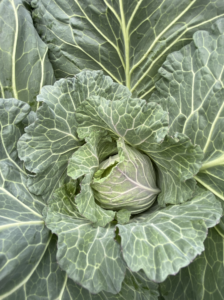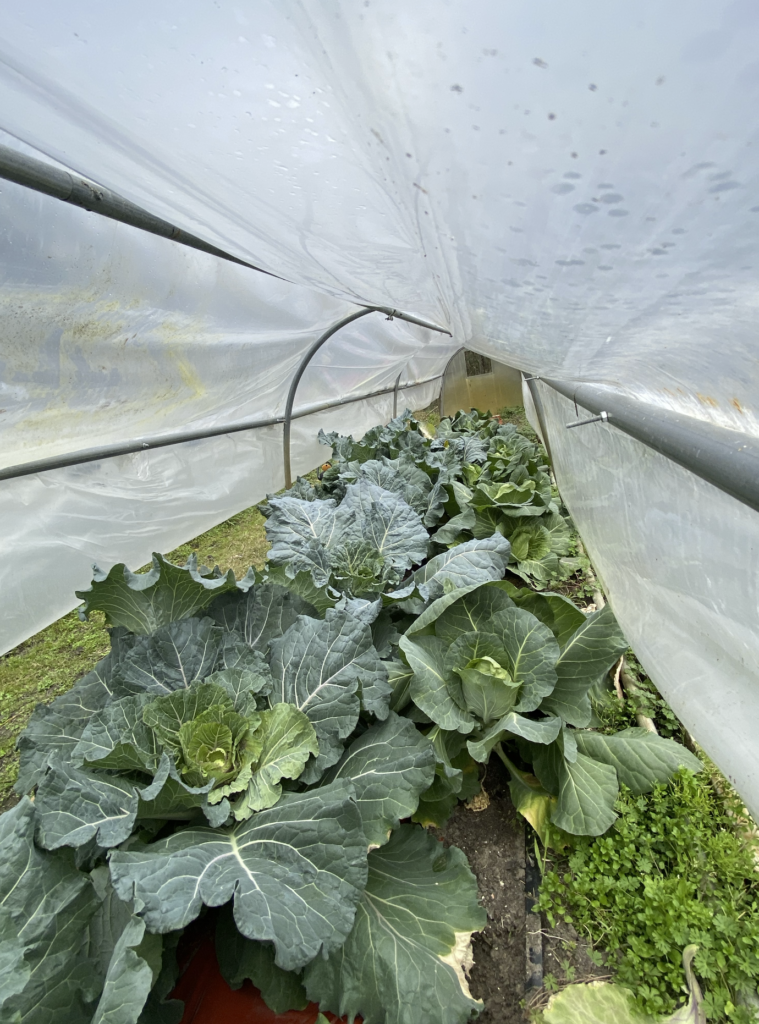According to historians, cabbage has been grown for thousands of years, some suggests as early as 2000 to 3000 BC by the ancient Chinese and Mesopotamians. Throughout the millennia, different strains from the brassica family were bred and created, this includes not only the cabbage you enjoy today, but broccoli, kale, cauliflower, Brussels sprouts, bok choy, and kohlrabi. Cabbage is most commonly eaten raw in salads and coleslaw, or pickled for kimchi and sauerkraut. It can also be boiled, sautéed, stir-fried, steamed, roasted, or included in dumplings.
Cabbage is very high in vitamin C, K, B6, folate, and fiber. Your most basic cabbages are large round green or red heads. Red and green cabbage have a slightly peppery and bitter flavor when eaten raw, but develop a sweeter flavor when cooked. A savoy cabbage is dark green in color and has a sweeter flavor. Chinese cabbages are more oblong in shape with a semi-sweet flavor. Cabbage is also commonly used to aid in digestion and help reduce cholesterol.
When and How to Plant Cabbage
 Cabbage is a biennial that needs full sun, a slightly acidic soil 6.5 – 7.0 pH, and a rich loamy soil. Cabbage is generally a cool weather crop and can be grown in a wide range of growing zones, from 1 to 10. Depending on where you live, there are many varieties that are bred for either cool or warm climates. Cabbage is a heavy feeder and will require a large amount of nutrient rich compost or aged manure.
Cabbage is a biennial that needs full sun, a slightly acidic soil 6.5 – 7.0 pH, and a rich loamy soil. Cabbage is generally a cool weather crop and can be grown in a wide range of growing zones, from 1 to 10. Depending on where you live, there are many varieties that are bred for either cool or warm climates. Cabbage is a heavy feeder and will require a large amount of nutrient rich compost or aged manure.
When starting from seed, sow your seeds a quarter inch deep and with 12 inches between each plant. Rows should be two feet apart. While transplanting your seeds, dig holes as deeps as the original container you are transplanting from, and place each cabbage 12 inches apart. Fertilizing your soil with a balanced 10-10-10 npk should be done two weeks after transplanting. A few weeks later, apply a nitrogen-rich liquid fertilizer.
Mulching around the cabbages can be a great way to minimize weeds and keep your soil moist, especially in warmer climates. Your optimal soil temperature should be 60 to 65 degrees. If cold weather is expected, utilize a cold frame to protect them.
Harvesting Cabbage
Cabbage takes approximately 70 days to mature. Depending on the variety it should be picked when they are 1 to 3 pounds per head. To harvest, remove any yellow leaves then utilize shears to cut the head at the base. It is possible to harvest twice as many heads from the same crop. Cut the head out from the outer layer and another smaller head should regrow. After harvesting, pull the entire root system from the ground to prevent disease, rot, and maggots from eating the stem.
Cabbage can be stored for a few weeks in the refrigerator. While storing cabbage, it is critical you dry out all the excess moisture clinging to the plant. Any excess moisture will cause it to rot.

Cabbage Pests and Diseases
Aphids will leave a sticky honeydew and black sooty mold on your cabbage. They will also cause your cabbage leaves to curl. Applying an insecticidal soap every few days for 2 weeks should help get your aphid infestation under control.
 Black rot is a fungus that will turn your cabbage leaves yellow and its veins black. The only way to rid your cabbage of black rot is to throw it away. Be sure to remove all crop residue, roots, and stem included.
Black rot is a fungus that will turn your cabbage leaves yellow and its veins black. The only way to rid your cabbage of black rot is to throw it away. Be sure to remove all crop residue, roots, and stem included.
Cabbage loopers and cabbageworms are caterpillars that will munch on the leaves of your cabbage and leave large jagged holes. Applying a crop cover before these caterpillars can climb into your cabbage is your first line of defense. If infestation has already begun, applying insecticidal soap, neem oil, and hand removing them are your best options.
Cabbage root maggots will cause your cabbage to appear wilted, stunted, and turn off-color. Apply a ring of diatomaceous earth and rotate your crops each season to help prevent these maggots.
Clubroot is a type of fungus that will cause your cabbage leaves to turn yellow, wilt, and stunt. Any plant infected with clubroot will need to be destroyed.
Downy mildew is one of the most common fungi that afflicts plants. It will cause a yellowish cottony growth on the undersides of the cabbage leaves that will eventually defoliate your cabbages. A copper-based fungicide or neem oil should be applied.
Flea beetles will swarm and eat the leaves of your cabbages leaving tiny little holes. Growing native plants that attract predatory insects like ladybugs should help clear up any flea beetle infestation.
Slugs and snails will eat and leave holes in the cabbage and leave disgusting slime trails. Using a copper plant collars and diatomaceous earth should help get these pests under control.
Thrips are insects that will cause the leaves to blister and turn brown, leaving scars and causing leaf curling. Insecticidal soaps can be employed and planting native plants to invite predatory insects that eat thrips is recommended.
White mold is a fungus that will cause the leaves to develop pale grey markings that later grow into blackish particles. Infected leaves will eventually rot and cause the plant to collapse. There is no cure for white mold so the entire cabbage must be discarded.
Cabbage Garden Planning
Starting a cabbage garden is easy if you’re utilizing the right garden planner. Hortisketch by Garden Savvy is the perfect solution to plan your cabbage garden. Simply click-and-drag cabbage beds to start planning your garden and property. Start planning today!

Contact Author
 info@gardensavvy.com
info@gardensavvy.com Recent Posts
- Smart Gardening: How Technology Is Revolutionizing Horticulture
- Understanding Gardening Zones: What You Need to Know
- The Right Tools For Your Gardening And Landscaping Needs
- Maximizing Your Harvest: Square Foot Gardening Chart for Beginners
- Holiday Garden Scents: Plants for Natural Aromatherapy in Your Home









